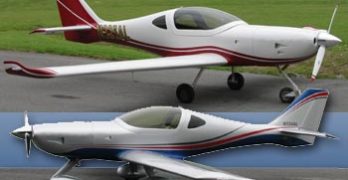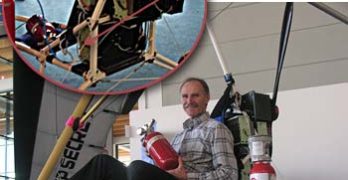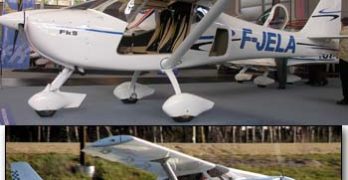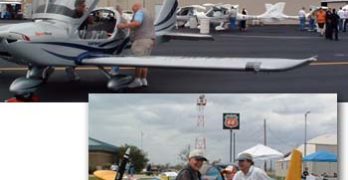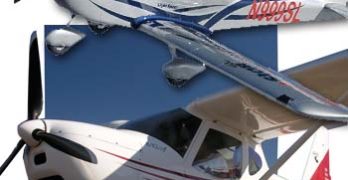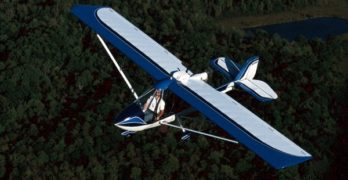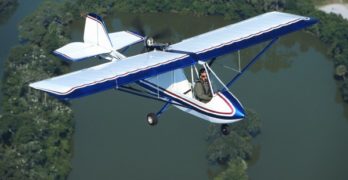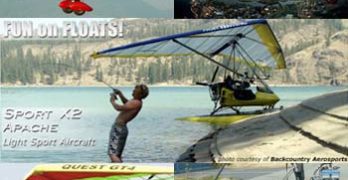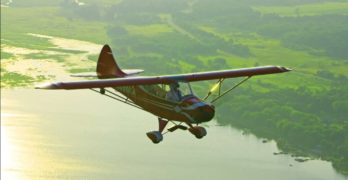After selling 40 aircraft under the Experimental Amateur Built (EAB) rule, Arion has now completed their SLSA approval just in the nick of time before the season-launching Sun ‘n Fun starts. Welcome to Lightning — SLSA #96 — from Arion Aircraft, which is our 69th company to enter production of Light-Sport Aircraft. *** Lightning got its start back when Jabiru-man Pete Krotje, his son Ben, plus Nick Otterback were dealers for the Spanish Esquale. That lead to the lovely low-wing Lightning though the design borrows from several light aircraft. It may sound like an organic development but the results are definitely worthy. I was highly impressed with a flight in an earlier EAB model, which did not have the speed limitations of LSA. “Extra wing area was added to bring wing loading and stall speeds into compliance with the applicable standards,” said Nick. *** Arion won approval on April 15, 2009.
Search Results for : flight design ct
Not finding exactly what you expected? Try our advanced search option.
Select a manufacturer to go straight to all our content about that manufacturer.
Select an aircraft model to go straight to all our content about that model.
Lighter-Than-Air… But Not An Airship
Research and practical applications are developing rapidly for electric-powered aircraft. Given my personal fascination, I’ll follow this regularly. So far, most electric power has been supplied by batteries — even in such as Flight Design’s hybrid aircraft engine unveiled at Aero 2009 However, that’s only one way to generate electric “fuel.” Hydrogen is another.
Forget fears of a Hindenburg airship exploding; even that fireball was likely precipitated by something other than hydrogen in the envelope (its paint is suspect). Today, the source is a relatively small tank of hydrogen (photo), supplied by companies like Messer which is sponsoring the work of Gerard Thevenot in creating his hydrogen fuel cell-powered trike.
Ultra-lightweight aircraft like trikes are a perfect platform for experimentation and Thevenot knows all about them. Gerard founded La Mouette, once the world’s largest producer of hang gliders. He’s highly inventive and well suited to such a project.
FK Lightplanes New Model; Offsetting Cirrus Stall
Most American pilots don’t recognize the brand FK Lightplanes, though many do know of one of their models. Cirrus Design based their celebrated entry into Light-Sport Aircraft upon the Fk14 Polaris. This lovely low wing looks enough like a Cirrus that the Duluth, Minnesota manufacturer selected it as their platform to offer what they called the SRS. *** The producer of the best-selling SR22 felt they needed to “Cirrus-ize” the Fk14, but now with the GA industry in sharp decline the company put the SRS project on hold to focus on their Vision jet (which sells for 10X more). *** Yet FK Lightplanes also builds a handsome high-wing model, which has gone through significant refinements in more than a decade on the market. “We’ll still make our Fk9 Mark 4 [the earlier model],” said company director Peter Funk, but his company is now launching the Fk9 ELA (as in European Light Aircraft), a version that more closely matches LSA specifications.
Heart of Texas LSA Expo Judged a Success
Exhibitor Chris Regis of Paradise USA (representing the P-1) reported “good visitor traffic” and “excellent organization” from the people behind the Heart of Texas LSA Expo. The new event, held over March 8 & 9 is one of two planned shows following the strong 2009 performance at the pioneer of LSA Expos, the Sebring U.S. Sport Aviation Expo. *** Several reports reminded me of the 13-city Sport Pilot Tour held during 2005 and 2006. Each of those events drew 10-20 exhibiting LSA and attracted 300-700 people at locations across the USA. The numbers sound small to those enamored of the huge crowds at Oshkosh. But, in fact, the Sport Pilot Tour, with its focused marketing on LSA only, helped customers find the manufacturer they were seeking. Everyone who came was interested in LSA and a vendor could speak to nearly all of them.
Light-Sport Aircraft… Leading the Way Up?
Sebring was a welcome event for all who participated. Companies that stayed home may be wondering if that was the right move. With record crowds, airplane orders taken, and merchandise selling out, the Florida LSA show gave a welcome lift to a global aviation industry that’s been laying off workers by the thousands. But, besides the general good news I’ve been asked dozens of times, “What was new?” at the event. Here’s my list; details will follow in other SPLOG posts. Surely I’ll leave out some worthy aircraft (you’ll tell me, I hope, and I’ll include them). *** In no particular order…the well-proven RANS S-6 Coyote debuted as an SLSA; Urban Air’s newly certified Samba complements their lovely Lambada; FPNA’s amphibious Cape Town appeared on brand-new floats; Paradise delivered their first hand-control P-1; Remos debuted their GX 2009 with new gear and a redesigned interior; a year after its debut at Sebring ’08 CTLS displayed the first-ever Garmin 696 installation, while the avionics company announced their GDU 370 and 375 MFDs; Evektor showed their SportStar SL with a recontoured exterior; Tony and Adriel Anderson showed their Fk9 on new Baumann amphib floats; they’re teaming up for sales with Hansen Air Group, which also showed a production version of their new FA-04 Peregrine; Zenith Aircraft constantly demo flew the STOL CH-750, an upgrade from their popular 701; Cessna identified notable changes in the final Skycatcher design (a larger tail) and confirmed first deliveries in ’09; and, the K-10 from Ukraine-based Skyeton made its worldwide debut…and made a sale.
Modestly-Priced, Easy-Flying Challenger Series
For 21 Years, Quad City’s Challenger has proved a good choice.
It’s enough to create a serious case of envy among producers vying for the market the Challenger seems to own year after year. Even in 2003, a slow year for all aircraft manufacturers, Quad City Ultralight Aircraft pumped out another 120 kits. Most light-sport aviation companies would consider that an excellent performance. For Quad City, it was a down year!
The venerable company from the Quad Cities area of Iowa, near the Illinois border, has put more than 3000 aircraft in the air. Van’s Aircraft has done even better, and Quicksilver has more than 10,000 ultralights flying, but the Challenger is clearly one of the industry’s leaders. And the company has enjoyed the same leadership since it was founded more than two decades ago.
Despite this success, Quad City maneuvers rather quietly. Last year the company celebrated 20 years of operation, yet many ultralighters and most aviators were unaware of the accomplishment.
Successful Low-Cost Light Planes
“I started the company in 1983, and I still own it,” reports Dave Goulet, the main man behind the Challenger aircraft design and Quad City Ultralight Aircraft Corporation. “In fact,” he adds, “it’s probably the oldest ultralight company still under the same management. “After reviewing all the ultralight companies I can think of, I’m inclined to agree.”
Thinking of other long-term operations, Goulet mentions The New Kolb Aircraft Company, whose roots are also planted deep, but even that storied company has now changed ownership… twice in the last decade, and most recently just a couple years ago.
Quicksilver Mfg. has been around longer, but the revolving door of managers and several changes of ownership have long since taken that familiar brand out of contention for continuous leadership.
About the only challenge to Challenger’s continuity reign that I can think of would be Chuck Slusarczyk, designer of the Hawk series, and his company, CGS Aviation.
Think All Trikes Are Foreign? Think Again!
Weight-shift control LSA, affectionately referred to as “trikes,” are often made overseas. That’s a bit weird as the concept originated in the USA and spread around the globe. Tens of thousands are flying, despite their relative rarity in America. So you could be excused for viewing trikes as foreign. Not all of them… *** Though it won approval last summer, the newest SLSA in the game — we now have 89 models from 67 companies — is the North Wing Design Sport X2, available in two models plus ELSA versions with alternate engines. The Navajo may represent the least expensive SLSA you can purchase, retailing for $29,000 ready-to-fly. An Apache model is more dressed out and runs $32,000, still quite a bargain in today’s world of $135,000 SLSA airplanes. (More price info.) *** North Wing is an all-American company from Washington state making both trike carriage and wings.
Savage Cub-like Taildragger
As we near the fourth anniversary of the introduction
of the first special light-sport aircraft
(S-LSA) in April 2004, notable successes have
been achieved. With approximately 1,000 fixed-wing
LSA-plus several hundred flex wings-in the national
fleet, and with the entry of Cessna and Cirrus into the
LSA marketplace, LSA have clearly become part of the
aviation scene.
Whatever the soothsayers predict for the future
of LSA, one fact has been established: Pretty yellow
taildraggers generate a solid following. Combining
the sales of American Legend Aircraft’s Legend Cub,
CubCrafters’ Sport Cub, and European supplier Zlin’s
Savage, nearly one in five S-LSA registered in the FAA’s
database are yellow taildraggers.
American Legend currently leads in market share, but
CubCrafters steadily rose through the ranks during 2007.
Well down the list, but with mounting registrations, is the
Zlin Savage. Though it more closely resembles the RANS S-7
Courier than the traditional J-3 Cub, the Zlin taildragger has
much to offer.
Luxurious Gobosh G-700S LSA
To Gobosh, LSA Means “Luxury Sport Aircraft”
Are luxury and light-sport aircraft (LSA)
compatible terms? Why shouldn’t they be? Some
automobiles are basic transportation machines
while others are luxurious, high-end cruisers.
That same variety can and should exist in the
world of aircraft, offering owners choices in
both price and “finish” of an airplane.
With luxury in mind,
one of the newer
entrants into the LSA
field, Gobosh Aviation,
introduced the Gobosh
G-700S to the U.S. market at EAA
AirVenture Oshkosh 2007. Built in
Poland by Aero Ltd. (see sidebar)
the G-700S is modified from Aero’s
AT-3, which has been produced
under European Joint Airworthiness
Requirements-Very Light Aircraft
(JAR-VLA) since 1999. About 30 AT-3s
are flying in Europe
What’s with Gobosh? What kind of
company name is that, you ask? Well,
Gobosh stands for “go big or stay
home.” One of Gobosh’s investors
hails from the high-tech computer
industry, and that’s his slogan in that
fast-paced, breakthrough-focused
world.
- « Previous Page
- 1
- …
- 113
- 114
- 115
- 116
- 117
- …
- 145
- Next Page »


